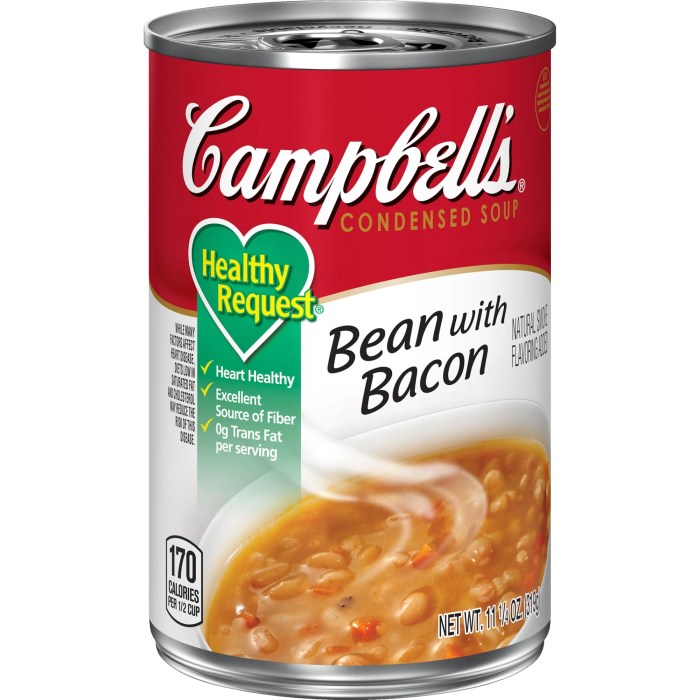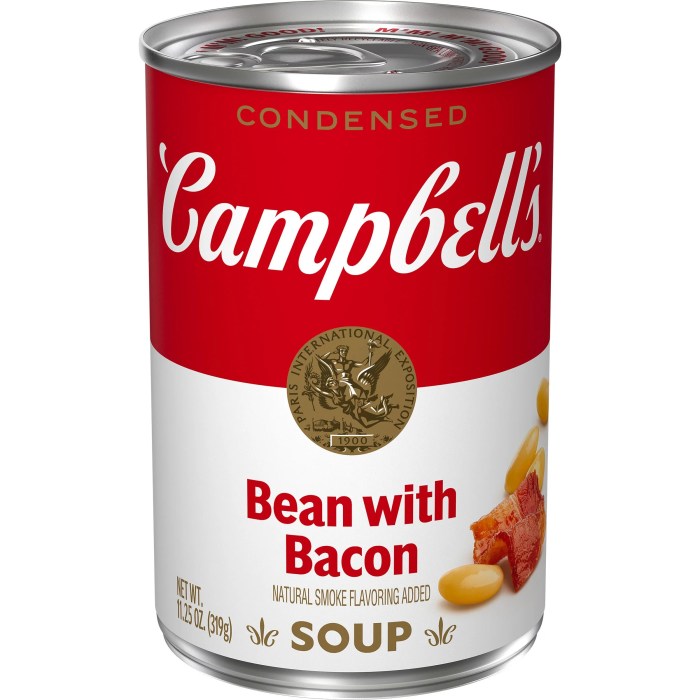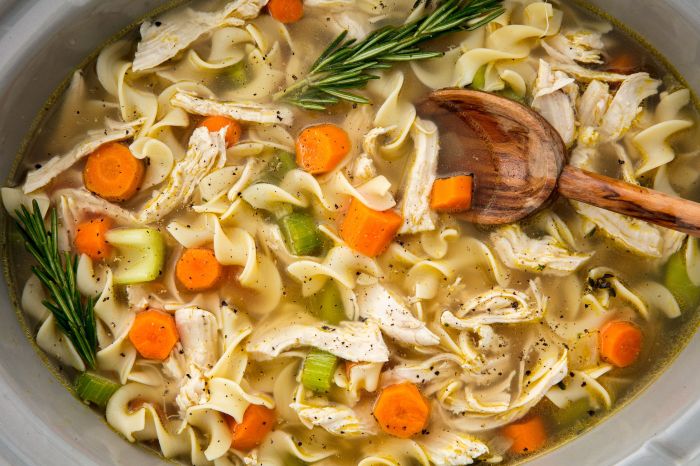Campbell’s Bean Soup Recipe Variations

Source: tasteofhome.com
Campbell’s bean soup recipe – Campbell’s Bean Soup provides a hearty and flavorful base, but its versatility allows for exciting variations by simply changing the type of beans used. This opens up a world of different textures and taste profiles, enriching the classic recipe. Exploring these variations not only diversifies your culinary repertoire but also offers opportunities to adjust the nutritional content of the soup to better suit individual dietary needs.
Bean Soup Variations and Nutritional Comparison
This section details three variations of Campbell’s Bean Soup, each featuring a different bean type, along with a comparison of their nutritional profiles. Approximate values are provided, as the exact nutritional content can vary based on specific bean types and preparation methods.
| Bean Type | Calories (per serving) | Protein (per serving) | Fiber (per serving) |
|---|---|---|---|
| Kidney Bean | 200-250 | 10-15g | 8-12g |
| Pinto Bean | 180-220 | 9-13g | 7-10g |
| Black Bean | 220-270 | 12-17g | 10-15g |
Flavor Profiles and Complementary Spices
Each bean type lends a unique flavor to the soup, and specific spices and herbs can enhance these characteristics.
The kidney bean variation offers a rich, earthy flavor. To complement this, smoky paprika, cumin, and a touch of chili powder create a Southwestern flair. A hint of oregano adds a Mediterranean touch. The natural sweetness of the kidney bean also pairs well with a touch of brown sugar.
Pinto beans bring a slightly nutty and creamy texture to the soup. For this variation, consider adding garlic powder, onion powder, and a bay leaf for a more savory profile. A pinch of cayenne pepper can provide a subtle kick. The earthiness of the pinto bean pairs well with thyme.
The black bean version provides a deep, slightly sweet, and subtly peppery flavor. This is beautifully enhanced by using cumin, coriander, and a touch of chipotle powder for a smoky heat. Fresh cilantro adds brightness and a refreshing aroma. Lime juice can also provide a zesty counterpoint to the earthiness of the black beans.
Ingredient Substitutions in Campbell’s Bean Soup

Source: walmartimages.com
Campbell’s Bean Soup, while delicious on its own, offers ample opportunity for customization. Substituting ingredients can alter the flavor profile, texture, and nutritional content, allowing for personalized adjustments based on dietary needs and preferences. This section will explore several common substitutions, detailing their impact and considering potential dietary implications.
Common Ingredient Substitutions and Their Effects
Swapping out ingredients in Campbell’s Bean Soup can lead to interesting variations. Five common substitutions and their effects on taste and texture are detailed below. Remember that the specific impact will depend on the brand and type of Campbell’s Bean Soup used as a base.
- Chicken Broth with Vegetable Broth: Replacing chicken broth with vegetable broth reduces the richness and savory depth of the soup, resulting in a lighter, more subtly flavored dish. This substitution offers a significant dietary benefit for vegetarians and vegans, while also potentially lowering the sodium content depending on the vegetable broth brand chosen. The texture remains largely unchanged.
- Kidney Beans with Black Beans: Substituting black beans for kidney beans introduces a slightly earthier, more subtly sweet flavor. The texture remains similarly firm, although black beans may have a slightly firmer bite. This swap offers a nutritional boost in antioxidants and fiber.
- Diced Tomatoes with Crushed Tomatoes: Using crushed tomatoes instead of diced tomatoes increases the soup’s overall thickness and creates a smoother, less chunky texture. The flavor becomes more intense and tomato-forward. This substitution doesn’t drastically alter the nutritional profile.
- Bacon with Smoked Ham Hock: Replacing bacon with a smoked ham hock adds a deeper, more complex smoky flavor to the soup, while also contributing a richer, more savory broth. The ham hock provides a more substantial meaty element than bacon. This substitution may increase the sodium content significantly, however.
- Onions with Leeks: Substituting leeks for onions offers a milder, sweeter onion flavor with a hint of garlic. The texture is slightly softer than onions. This swap provides similar nutritional benefits to onions but with a less pungent flavor profile.
Dietary Considerations for Ingredient Substitutions
Choosing substitutions carefully can address various dietary needs and restrictions. Consider these points when making changes to your Campbell’s Bean Soup recipe:
- Gluten-Free: Campbell’s Bean Soup is generally gluten-free, but always check the label to be certain. Substituting ingredients should not introduce gluten, unless using a gluten-containing product like Worcestershire sauce (ensure to choose a gluten-free version if needed).
- Dairy-Free: Campbell’s Bean Soup is naturally dairy-free. Maintain this by avoiding any dairy-containing additions during the substitution process.
- Low-Sodium: Use low-sodium broths and be mindful of added salt when making substitutions. Many prepared broths are high in sodium.
- Vegetarian/Vegan: Replace chicken broth with vegetable broth and avoid any meat-based additions to maintain a vegetarian or vegan diet. Check labels to ensure all ingredients are compliant.
Cooking Methods for Campbell’s Bean Soup Recipe
Campbell’s Bean Soup, while delicious on its own, can be elevated with different cooking methods. Stovetop and slow cooker methods offer distinct advantages and disadvantages, impacting both the time investment and the final taste and texture. Choosing the right method depends on your available time and desired outcome.Stovetop and Slow Cooker Methods Compared
Stovetop Method
The stovetop method offers a quicker route to a warm bowl of Campbell’s Bean Soup. It involves heating the soup in a pot on the stove, allowing for easy monitoring and adjustment of consistency. This method is ideal for weeknights when a quick and easy meal is needed.Advantages: The stovetop method is significantly faster than slow cooking, typically taking around 15-20 minutes.
It also allows for more immediate adjustments to seasoning and consistency. The soup can be easily thickened if needed by simmering uncovered for a longer period.Disadvantages: Requires more active supervision compared to slow cooking. There’s a higher risk of burning if not carefully monitored, particularly if the soup boils vigorously. The final product might not achieve the same depth of flavor as slow-cooked soup, although this difference is often subtle.
Slow Cooker Method
The slow cooker method provides a hands-off approach, perfect for busy individuals or those who prefer a more intense flavor profile. The low and slow cooking process allows the flavors to meld and deepen over several hours.Advantages: Minimal active cooking time; simply add the ingredients and let the slow cooker do the work. This method yields a richer, more flavorful soup due to the extended cooking time.
It’s also ideal for meal prepping, as the soup can be kept warm for hours.Disadvantages: Requires significantly more time, often 4-6 hours on low or 2-3 hours on high. The slow cooker method might result in a slightly thinner soup compared to the stovetop method, although this can be mitigated by adjusting the liquid quantity. You cannot easily adjust seasoning or consistency during the cooking process.
Adjusting Cooking Times and Ingredient Quantities
Cooking times and ingredient quantities can be easily adjusted based on the chosen cooking method. For the stovetop method, simply reduce the cooking time if using pre-cooked beans or if you prefer a less intense flavor. Conversely, increase the simmering time to thicken the soup. For the slow cooker, increase the cooking time for a more intense flavor, but be mindful that overcooking can result in a mushy texture.
Adjusting liquid quantities can also impact the final consistency; adding less liquid in both methods results in a thicker soup. For example, using a 10.75 ounce can of Campbell’s Bean Soup as a base, you might reduce the added liquid by a quarter cup when using the stovetop method for a thicker result, or by half a cup for the slow cooker to achieve a similar consistency.
Always taste and adjust seasonings as needed, regardless of the chosen method.
Campbell’s bean soup recipe is a classic, comforting choice, but if you’re looking for a lighter option, consider a cleansing approach. For a seven-day dietary cleanse, you might explore alternatives like the cabbage diet soup recipe 7 days , which offers a different flavor profile altogether. Afterwards, you can always return to the hearty goodness of Campbell’s bean soup.
Serving Suggestions and Recipe Enhancements: Campbell’s Bean Soup Recipe

Source: heb.com
Campbell’s Bean Soup, while delicious on its own, offers a canvas for culinary creativity. Simple additions and thoughtful pairings can elevate this classic comfort food to new heights, transforming a familiar meal into a memorable experience. The following suggestions explore both creative serving options and flavorful enhancements to the basic recipe.
Creative Serving Suggestions for Campbell’s Bean Soup
The versatility of Campbell’s Bean Soup allows for a wide range of accompaniments. Consider these pairings to enhance the overall dining experience, playing with textures and flavors to create a more satisfying and complete meal.
- Cornbread Crumbles: The sweetness of crumbled cornbread provides a delightful contrast to the savory soup, adding a textural element that elevates the simple dish. The crumbles soak up the flavorful broth, creating a delightful mouthful.
- Grilled Cheese Sandwich: A classic pairing, the melted cheese and toasted bread offer a comforting counterpoint to the hearty soup. The richness of the cheese complements the beans’ earthiness.
- Side Salad with a Vinaigrette: A fresh, crisp salad with a light vinaigrette cuts through the richness of the soup, offering a refreshing contrast. Consider a simple green salad with cherry tomatoes and cucumbers.
- Spicy Sausage Crumbles: Adding crumbled spicy Italian sausage to the top of the soup adds a savory kick and a delightful textural contrast. The spice level can be adjusted to individual preferences.
- Sourdough Bread Bowl: Serve the soup in a hollowed-out sourdough bread bowl for a rustic and flavorful presentation. The bread absorbs the soup’s flavors, creating a delicious edible bowl.
Recipe Enhancements for Campbell’s Bean Soup
These enhancements build upon the foundation of Campbell’s Bean Soup, adding depth of flavor and visual appeal. Each enhancement offers a unique taste profile and textural experience.
- Smoked Sausage Enhancement: Adding diced smoked sausage to the soup infuses it with a smoky, savory flavor. The sausage’s texture adds a pleasing chewiness to the overall consistency. A medium-heat smoked sausage works particularly well, balancing the smokiness with a subtle spice.
- Chorizo Enhancement: The addition of chorizo provides a bold, spicy kick to the soup. The rich, slightly oily texture of the chorizo adds a layer of complexity to the broth, enhancing its visual appeal with vibrant reds and oranges.
- Roasted Vegetable Enhancement: Roasting vegetables like carrots, bell peppers, and onions before adding them to the soup intensifies their natural sweetness and creates a deeper, more complex flavor profile. The roasted vegetables add a contrasting color and texture to the soup.
Visual Appeal of Enhanced Campbell’s Bean Soup
The visual appeal of each enhanced version of the soup is significantly improved. The smoked sausage version maintains a warm, earthy tone with flecks of darker brown from the sausage. The chorizo enhancement introduces vibrant reds and oranges, creating a more visually striking and appetizing bowl. Finally, the roasted vegetable version presents a colorful array of textures and hues, showcasing the varied colors of the roasted vegetables against the creamy base of the soup.
The roasted vegetables add a pleasant textural contrast to the smooth bean soup.
Historical Context of Campbell’s Bean Soup
Campbell’s Bean Soup, a seemingly simple staple in many American pantries, boasts a surprisingly rich history intertwined with the evolution of canned food and the changing tastes of the nation. Its journey reflects broader shifts in American eating habits, marketing strategies, and the cultural significance of convenient, affordable food.The origins of Campbell’s Bean Soup are rooted in the company’s early innovations in food preservation and processing.
While the exact date of its introduction is difficult to pinpoint precisely, its development likely aligns with the broader expansion of canned goods in the late 19th and early 20th centuries. The rise of industrial canning techniques made it possible to produce and distribute shelf-stable soups on a large scale, fundamentally altering food availability and consumption patterns across the country.
Early versions of the soup likely differed significantly from the modern iteration, with variations in ingredients and preparation methods reflecting the available technology and prevalent culinary preferences of the time.
Campbell’s Bean Soup’s Rise in Popularity, Campbell’s bean soup recipe
Several key marketing campaigns and historical moments significantly contributed to the soup’s widespread popularity. The development and widespread adoption of the iconic Campbell’s Soup label, with its distinctive red and white design, played a crucial role in establishing brand recognition and consumer trust. This visual branding, consistent across a wide range of products, fostered a sense of familiarity and reliability that became deeply ingrained in American culture.
Furthermore, Campbell’s strategic advertising, often featuring heartwarming imagery and relatable family settings, effectively positioned the soup as a convenient, affordable, and comforting meal option for busy households. The company’s ability to adapt its marketing strategies to reflect evolving social trends, coupled with consistent product quality, further solidified its position as a household staple.
Cultural Significance of Campbell’s Bean Soup
Campbell’s Bean Soup occupies a unique place in American culinary culture. It’s frequently associated with notions of comfort, nostalgia, and practicality. Its presence in countless kitchens and its portrayal in popular media – from advertisements to literature – have solidified its status as a cultural icon. The soup’s affordability and accessibility have made it a ubiquitous presence across different socioeconomic groups, transcending regional and demographic boundaries.
Its enduring popularity speaks to its consistent quality, convenient format, and its ability to evoke feelings of warmth and familiarity for many Americans. This lasting legacy underscores its significant role in the American food landscape.
Helpful Answers
Can I use canned beans instead of dried beans?
Yes, using canned beans significantly reduces cooking time. Just be sure to rinse them well before adding them to the soup.
What happens if I overcook the soup?
Overcooked soup may become mushy. For best results, follow the cooking time guidelines closely and avoid prolonged simmering.
Can I freeze Campbell’s Bean Soup?
Yes, Campbell’s Bean Soup freezes well. Allow it to cool completely before storing in airtight containers for up to three months.
Is Campbell’s Bean Soup gluten-free?
The basic recipe is typically gluten-free, but always check the labels of any added ingredients like broth or seasonings.


